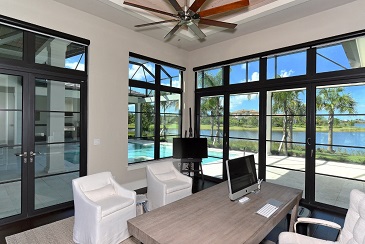 NATIONAL REPORT—Walls featuring large contiguous windows and glass doors are a popular theme within the hotel industry. Used to showcase wonderful views and provide access to grounds in summer, these features also allow natural light to stream into buildings.
NATIONAL REPORT—Walls featuring large contiguous windows and glass doors are a popular theme within the hotel industry. Used to showcase wonderful views and provide access to grounds in summer, these features also allow natural light to stream into buildings.
Creating low-energy or zero-energy buildings (ZEB) is an increasingly important goal for the sector. Hotels and other tourist accommodations are typically energy-intensive buildings, making the integration of renewable energy systems and energy efficiency measures more vital.
Over the last 20 years, countries across Europe have greatly increased their use of renewable energy sources (RES), particularly in the building industry. This includes wind power, hydro systems and the harnessing of solar energy (PV and solar thermal).
One area which can be easily capitalized upon to reduce energy consumption and keep bills down is solar gain.
What is Solar Gain?
Solar gain is when short-wave radiation from the sun increases the temperature inside a property. A building can take advantage of this by:
- gathering heat when the sun shines through a window; and
- keeping it surrounded by materials that store heat, such as concrete, brick and stone—also known as “thermal mass”.
According to some reports, up to 75 percent of the sunlight that hits a window is converted into thermal energy. Using solid materials in a building’s structure means solar gains can be stored through the day then released as the temperature drops. The same materials also absorb heat from warm air in the hotel during the colder months.
Solar heat is transferred and stored in different areas of the building by radiation and convection.
Duncan McCombie, CEO of heating and renewable energy experts YES Energy Solutions, said: “Theoretically, passive solar gain is good as it provides free heat across the year. The solid elements of the construction of a building (the thermal mass) warm up in the sun’s heat, slowly releasing it like a radiator when the sun goes down. The number of hours of heating that might be saved is hotel-specific and relates directly to its construction and insulation, as well as the thermal gain from the sun, so it is also weather-related.”
How to Make Your Hotel as Efficient as Possible
Although windows are an important part of any hotel design, they can also cause draughts, making the colder months extremely expensive. To prevent this, substitute old single-glazed windows and doors with thermally efficient double-glazed frames which can cut energy bills by an average of 12 percent.
Joe Halsall, Digital Marketing Manager at windows and door specialists Origin Global, says: “Having large windows can be very aesthetically pleasing and the size doesn’t need to be compromised in order to retain heat. With the use of solar gain, large windows and doors can be environmentally friendly, create a more comfortable living space and save the hotel owner money.”
When fitting more efficient windows, always consider:
- the U-factor—a measure of how much heat the window will let escape; and
- the Solar Heat Gain Coefficient (SHGC)—the fraction of heat radiated from the sun that travels through a window to the inside of a property.
To keep your hotel as warm as possible during cooler months, you would want a low U-factor and a high SHGC, but this will vary depending on the climate in which you live.
Low emissivity (Low-E) glass, which often has an invisible coating of metal oxide, is the most energy-efficient type of double glazing. It absorbs light and heat and lowers the volume of heat that can seep out.
Colin Rees, Consulting Manager of IES, a world leader in 3D performance analysis software used to design energy-efficient buildings, said: “Solar gain is an important element when considering a building’s energy and comfort performance. Assessing the building’s façade and passive design strategies is significant due to the interaction of solar gain and how this is either captured through glazing and thermal mass, or rejected through local shading, and avoided due to surrounding buildings/topography. Correctly assessing solar capture has a great impact on the building’s peak space loads and how to reduce plant need and then accurately size plant capacities.”
The orientation of a building can have a dramatic effect on solar gain, so taking advantage means carefully choosing where you buy or build a property.
For maximum efficiency, it’s important to place new windows or bi-fold doors where they will receive the most sunlight. North-facing windows admit an even amount of light that doesn’t produce a glare, while south-facing windows adapt well to seasonal changes by absorbing plenty of heat through winter and less during summer. This makes them more valuable than east-facing or west-facing windows, which are poor at adjusting temperatures through extremes of heat or cold.
Duncan McCombie said: “The additional benefit of having suitable doors, bi-fold or tri-fold, is beyond the obvious savings. Reducing draughts and leaking heat from gaps brings great energy savings. However, there is an equally important comfort and aesthetic benefit that is achieved by having a ‘usable space’.”
Reducing Solar Gain in Hotter Climates
Solar gain can be extremely beneficial during winter but threatens overheating through the hotter months. To avoid this, shade windows from direct sunlight. Blinds, curtains and even deciduous trees planted in front of windows can limit solar gain through summer, without it affecting the rise of solar heat needed in winter.
Colin added: “Air-conditioning systems are commonly placed to manage the cooling requirements due to captured solar gains, particularly in buildings with highly glazed façades. However, the AC will not solve potential high mean radiant temperatures on space surfaces so operative temperatures may still be high. Analysis and interrogation will unlock these findings. Where buildings experience high occupancy then correctly managing solar gains is imperative to avoid overheating for naturally ventilated spaces.”
Hotel owners can minimize the need for air-conditioning by using heat-reflective glass. The glass enables visible light to pass through, while the reflective coating (which has a mirror-like appearance) reduces heat gain and glare.
Colin said: “Exposure to solar gains and managing how they work with a building can often be the deciding factor to a high-performance building or one where occupants experience significant discomfort.”
Increasingly, people are looking for ways to help the environment and reduce their carbon footprint, be it through cutting down on plastic packaging or reducing air miles. Harnessing the sun to reduce lighting and heating bills is another great way to make changes.
While many hotel owners consider adding bi-fold doors to their property because of their style and functionality, they also allow you to let the sun into your building and benefit from the heat and warmth it supplies.





